Ohio is once again using the Johnson & Johnson/Janssen vaccine in its fight against coronavirus.
After nearly two weeks of investigating extremely rare blood clots associated with the Johnson & Johnson COVID-19 vaccine, the Centers for Disease Control and Prevention (CDC) and the Food and Drug Administration (FDA) said Friday that the vaccine remains safe and effective.
Previously, the U.S. agencies had strongly recommended on April 13 that providers pause administering the Johnson & Johnson COVID-19 vaccine while they reviewed six cases of severe blood clots in women who had received the vaccine. The agencies also asked for time to provide education to health providers and vaccine administrators because the rare post-vaccine clots must be treated differently from traditional blood clots.
Most states, including Ohio and Kentucky, paused J&J vaccine distribution immediately.
Shortly after the CDC and FDA shared their findings on Friday, Ohio gov. Mike DeWine lifted the pause in the Buckeye State.
DeWine emailed the following statement (emphasis is his):
Our country’s vaccine safety system has worked as designed – these extremely rare, serious blood-clotting events were reported into the CDC’s Vaccine Adverse Event Reporting System (VAERS), and the vaccine distribution was paused to allow a thorough review of the facts and time to educate healthcare providers on the rare events. Now, a comprehensive analysis by the independent medical professionals on the ACIP has resulted in the recommendation that the benefits of Johnson & Johnson vaccine outweigh the risks, and that vaccine administration resume. The CDC and FDA have accepted those recommendations, lifting the pause on the Johnson & Johnson COVID-19 vaccine. Providers in Ohio are permitted to immediately resume administering Johnson & Johnson vaccines in Ohio, provided they continue to follow all guidance by the CDC and FDA.
As of press time, Kentucky Gov. Andy Beshear has not addressed the CDC's new recommendation about the Johnson & Johnson vaccine.
In statements Friday, CDC and FDA officials expressed confidence in the Johnson & Johnson vaccine's safety and noted the rare nature of the special type of blood clots that formed after the six women received their shots.
"We have concluded that the known and potential benefits of the Janssen COVID-19 Vaccine outweigh its known and potential risks in individuals 18 years of age and older. We are confident that this vaccine continues to meet our standards for safety, effectiveness and quality," Janet Woodcock, M.D., acting FDA commissioner, said.
"Our vaccine safety systems are working. We identified exceptionally rare events – out of millions of doses of the Janssen COVID-19 administered – and we paused to examine them more carefully," added Rochelle P. Walensky, CDC director. "As we always do, we will continue to watch all signals closely as more Americans are vaccinated. I continue to be encouraged by the growing body of real-world evidence that the authorized COVID-19 vaccines are safe and effective, and they protect people from disease, hospitalization, and death."
On April 13, the agencies announced that about six to 15 days after getting the J&J vaccine, six women ages 18-48 developed cerebral venous sinus thrombosis (CVST) — a rare blood clot in the brain — alongside a low number of platelets, which are tiny blood cells that bond to stop the bleeding when parts of the body are damaged.
The combination of CVST and a low platelet count is extremely rare, experts say.
"Usually, an anticoagulant drug called heparin is used to treat blood clots. In this setting, administration of heparin may be dangerous, and alternative treatments need to be given," the CDC said. "(Pausing distribution) is important, in part, to ensure that the health care provider community is aware of the potential for these adverse events and can plan for proper recognition and management due to the unique treatment required with this type of blood clot."
During a briefing with DeWine earlier this month, Dr. Susan Koletar, director of Ohio State University’s division of infectious diseases at the Wexner Medical Center, said that most people receiving the vaccine will not experience this blood clot.
“There’s a lot of thought and work being done, probably as we speak, looking at specific immune reactions or autoimmune reactions that occur and affect the platelets, which allow blood to clot,” Koletar said. “And it’s an interesting and rare event where there’s situations where the platelets are low but there’s still all this clotting. The clots that have been seen have been more rare than others.”
During an April 15 meeting of the CDC’s Advisory Committee on Immunization Practices (ACIP), experts reviewed data on CVST, but because most existing data does not also include information about low platelet count, the agency postponed recommending specific actions and continued its review.
About 7 million people in the United States have received the J&J vaccine, and at the time the CDC and FDA paused distribution, these six women were the only people known to have experienced this type of clotting. The CDC has updated its total cases to 15, including some identified after the initial six.
The Vaccine Adverse Event Reporting System (VAERS), where providers and physicians note issues of concerns nationally, alerted federal agencies to the blood clot cases.
The Johnson & Johnson COVID-19 vaccine received emergency use authorization in February. Two other vaccines from Pfizer and Moderna were authorized in December.
Unlike the Pfizer and Moderna vaccines that require two doses several weeks apart, the J&J vaccine needs only a single dose, making it effective for college students, people without homes, people who are in corrections facilities, minority groups and people who are less likely to return for a second dose of the other vaccines.
Pfizer and Moderna vaccines were unaffected by the J&J pause and continue to be considered safe and effective.






